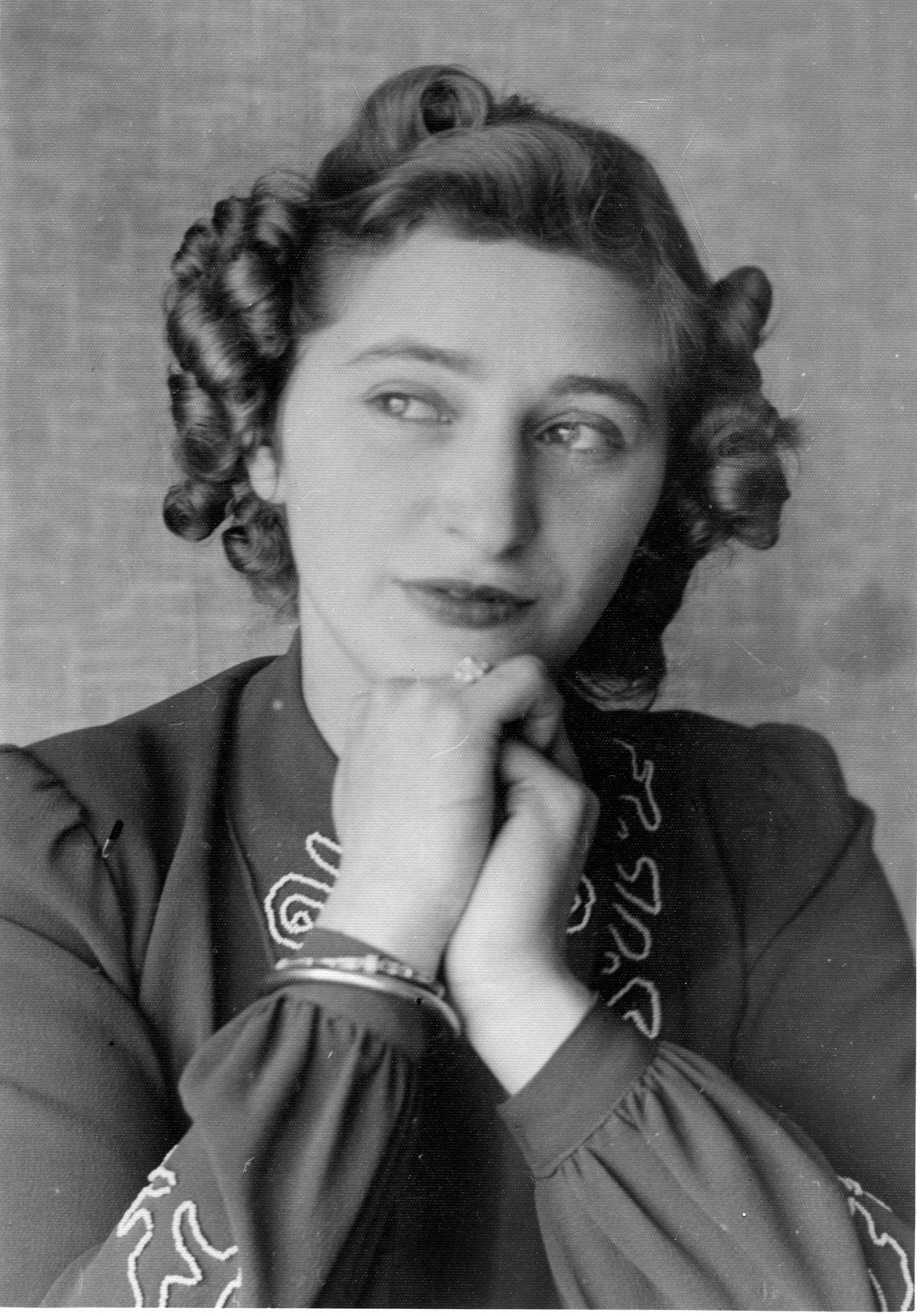Leny Boeken - Velleman
Leny Boeken-Velleman was with the eight people from the Secret Annex in the punishment barracks at Westerbork camp and went on the same transport to Auschwitz concentration camp.
Lena (Leny) Velleman was born at the New Israelite Hospital in Amsterdam on 22 November 1922.[1] Her younger brother Andries was born on 5 December 1926.[2] The family lived during the summer months in Zandvoort, where mother Hannah Velleman-Frenkel (1894-1944) had a cigar shop, and during the winter months they lived in Amsterdam. When Leny was six, the family went to live permanently in Amsterdam.[3] Father Jacob Velleman (1897-1944) was a tailor and worked at the Hollandia Kattenburg raincoat factory in Amsterdam North.[4]
After primary school, Leny attended the Industrial School. From the age of 15, in 1937, she went to work in the women's fashion shop Gerzon, which had been founded in 1889 by the Jewish brothers Lion and Eduard Gerzon.[5] A few years later, she went to work at the luxury perfume shop Stawo at 5a Beethovenstraat.[6]
In June 1941, she got engaged to René, a friend of her cousin who was lodging with the Velleman family.[7]
In mid-June 1942, Leny's younger brother was arrested for not carrying his identity card and not being able to prove that he was only 15 years old. He was released. Shortly afterwards, she was called up for labour in Germany and had to report at the Central Station. This prompted her parents to go into hiding. Her fiancé had already arranged for a hiding address.The family first went into hiding for a weekend on Kloveniersburgwal and then on Prinsengracht, opposite what is now the Anne Frank House. After that the house on Prinsengracht became dangerous, the family members were split up and Lenie, without her parents and brother, went into hiding with an accountant in the Jordaan. A few weeks later, she moved again and ended up with a family on Stadionweg. From November 1942, she and several others, including her fiancé's sister, spent almost two years in hiding at an address in Zeist.[8]
On 18 August 1944, the Zeist house was betrayed by Wilhelmus (Willem/Wim) Johannes Hendricus Houthuys (1902-1985), who was known as Meerman and had reported several addresses in Zeist to the SD.[9]
Concentration camps
After having been held for several days at the SD headquarters on Euterpestraat in Amsterdam, Leny arrived at Camp Westerbork on 21 August 1944. There, like the eight people from the Secret Annex, she ended up in punishment hut 67. She was put to work on battery disposal.[10]
On 3 September 1944, like the people from the Secret Annex, she was transported to Auschwitz concentration and extermination camp.[11] Upon arrival, she was registered and had the number A 25239 tattooed on her forearm.[12]
In November 1944, Leny was deported to a camp in what is now the Czech Republic near the town of Chrastava (Krazau). There she first joined the 'potato command' and then worked in a factory where weapons were made. Due to mistreatment, illness and medical experiments, Leny became severely weakened. In May 1945, the camp was liberated by the Soviet army. Leny had to recover in several hospitals for a long time before she could return to the Netherlands.[13]
After the war
In 1946, Leny met Samson (Sven) Boeken (1920-1987), whom she married on 28 May 1947, at a dance night at a community centre.[14]
From 1996, Leny joined the 'Poland trip' of the Dutch Auschwitz Committee. During these trips she recounted her camp experiences.[15]
On 17 April 2012, Leny died in Amsterdam, aged 89.[16]
Source: personal information.[1] Address. Amsterdam: Rivierenlaan 124-II.
Footnotes
- a, b Leny Boeken Velleman Breekbaar, maar niet gebroken. Het verhaal van een Auschwitz-overlevende, Laren: Uitgeverij Verbum, 2008, p. 14. Stadsarchief Amsterdam (SAA), Dienst Bevolkingsregister, Persoonskaarten (toegangsnummer 30408): Persoonskaart Lena Velleman.
- ^ Andries Velleman werd op 31 maart 1944 vermoord in Auschwitz. SAA, Dienst Bevolkingsregister, Archiefkaarten 9toegangsnummer 30238): Archiefkaart Andries Velleman.
- ^ Boeken Velleman Breekbaar, maar niet gebroken, p.15.
- ^ Naast de Joodse eigenaren had Hollandia Kattenburg veel Joodse werknemers. Bij een razzia op 11 november 1942 werden 367 Joodse personeelsleden gearresteerd. Ook hun gezinnen werden meegenomen. Het was een van de grootste bedrijfsrazzia’s in de geschiedenis. Van het transport van 826 mannen, vrouwen en kinderen keerden slechts 8 mannen terug. Herdenking Hollandia Kattenburg: De geschiedenis van Hollandia Kattenburg; Boeken Velleman Breekbaar, maar niet gebroken, p. 18.
- ^ Boeken Velleman, Breekbaar, maar niet gebroken, p. 24; Verzetsmusuem Amsterdam: Modehuizen.
- ^ Boeken Velleman, Breekbaar, maar niet gebroken, p. 24; ‘Advertentie Stawo’, Het Volk, 25 mei 1939.
- ^ Boeken Velleman Breekbaar, maar niet gebroken, p. 26.
- ^ Boeken Velleman, Breekbaar, maar niet gebroken, p. 37-55.
- ^ Boeken Velleman, Breekbaar, maar niet gebroken, p. 55. Sytze van der Zee, Vogelvrij. De jacht op de Joodse onderduiker, Amsterdam: De Bezige Bij, 2010, p. 361; Ad van Liempt & Jan H. Kompagnie (red.), Jodenjacht: de onthutsende rol van de Nederlandse politie in de Tweede Wereldoorlog, 2011, p. 75-84.
- ^ Boeken Velleman, Breekbaar, maar niet gebroken, p. 58, 65; Arolsen Archives - International Center on Nazi Persecution, bad Arolsen: Joodsche Raad kaart Lena Velleman, Document ID: 130389107.
- ^ Arolsen Archives: Joodsche Raad kaart Lena Velleman.
- ^ Boeken Velleman Breekbaar, maar niet gebroken, p. 90.
- ^ Boeken Velleman, Breekbaar, maar niet gebroken, p. 104-124.
- ^ Boeken Velleman, Breekbaar, maar niet gebroen, p. 143; SAA, Dienst Bevolkingsregister, Archiefkaarten (toegangsnummer 30238): Archiefkaart Samson Boeken
- ^ Boeken Velleman Breekbaar, maar niet gebroken, p. 152.
- ^ Online Familieberichten: Leny Velleman.
